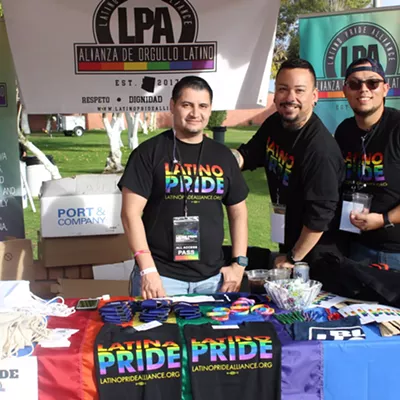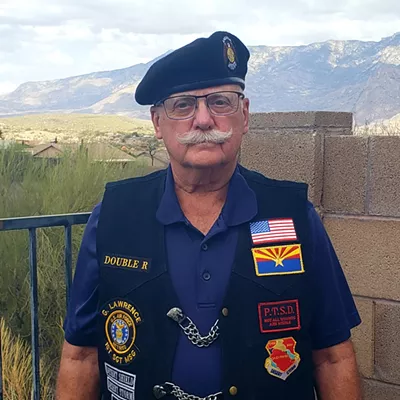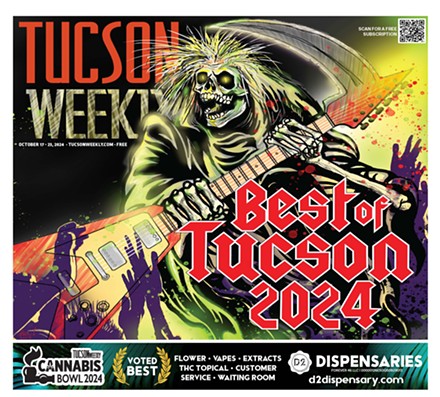The survey of 400 Congressional District 8 voters, which was conducted by local pollster Margaret Kenski, showed that half favor Giffords, while 35 percent say they will vote for Graf, and 11 percent remain undecided.
Just 2 percent of voters said they were supporting Libertarian David Nolan, while 1.5 percent said they liked independent Jay Quick.
The poll, taken between Oct. 25 and 28, has a margin of error of plus or minus 4.3 percent.
The latest numbers don't show a major shift from a Weekly poll taken in September, which showed that 52 percent supported Giffords, and 34 percent supported Graf.
But Kenski notes that 26 percent of Giffords supporters say they support her based on her positions on the issues, compared to just 15 percent in September, which Kenski credits to Giffords' television advertising.
"Whatever you think of what she does in those ads, she's become identified with certain issues more than she was," says Kenski, who notes that Graf has had far less money to advertise.
When it comes to the top issues facing the candidates, voters continue to have more confidence in Giffords than in Graf. Forty percent of voters say they trust her centrist approach to resolving border security, while 36 percent prefer Graf's hard-line stance.
When it comes to handling the Iraq war, 40 percent say they have more trust in Giffords, while just 29 percent say they have more trust in Graf.
The Weekly poll is the latest in a series of publicly released surveys that have shown Graf unable to break the 40 percent barrier. His highest showing was 38 percent, in a poll released last week by Zimmerman and Associates, which showed him trailing Giffords by 10 percentage points.
A staunch conservative, Graf is struggling to maintain GOP support in the moderate 8th District, which stretches from the Catalina foothills to the U.S.-Mexico border. Just 65 percent of Republicans say they'll vote for Graf; 20 percent say they'll support Giffords, and 13 percent remain undecided.
Some of the GOP crossover appears to be a reaction to Graf himself. As one Republican told pollsters, "Graf is too conservative for me." But in other cases, it appears related to dissatisfaction with the Republican Party in general, with one GOP Giffords supporter saying he'd be "darned" if he'll vote Republican this year.
On the other side of the aisle, 86 percent of Democrats say they'll vote for Giffords; 6 percent say they'll cross over to support Graf, and 8 percent are undecided.
One Democrat who is supporting Graf told pollsters that he liked the Republican's opposition to abortion and gay marriage, while another said he liked Graf's stance on the border.
Independent/other voters are supporting Giffords by a better than 2-to-1 margin, with 48 percent supporting Giffords, and 22 percent supporting Graf. Nine percent support Nolan, and 7 percent support Quick. Thirteen percent of independent voters are undecided.
Graf has yet to overcome his gender gap. Nearly 54 percent of female voters support Giffords, while 32 percent support Graf. Giffords also leads among male voters, with 46 percent saying they'll vote for her and 38 percent saying they'll vote for Graf.
Giffords continues to dominate in Pima and Pinal counties, where 51 percent of the voters say they'll support her, compared to 35 percent for Graf.
Graf has also lost his lead in Cochise and Santa Cruz counties. In September, he had the support of 43 percent of voters, but the new survey shows he has slipped to 39 percent. Giffords, who had the support of 42 percent in September, has climbed to 46 percent.
Of the voters who are supporting Graf, 13 percent said they were voting for him because they always vote Republican; 7 percent said they like his stand on the border, and 6 percent said they liked his stand on issues overall.
The poll surveyed 400 voters who cast ballots in the 2002 and 2004 general elections, including 333 voters from Pima and Pinal counties and 67 voters from Cochise and Santa Cruz counties. The sample included 185 Republicans, 161 Democrats and 54 independent/other voters; 204 were women, and 196 were men.










